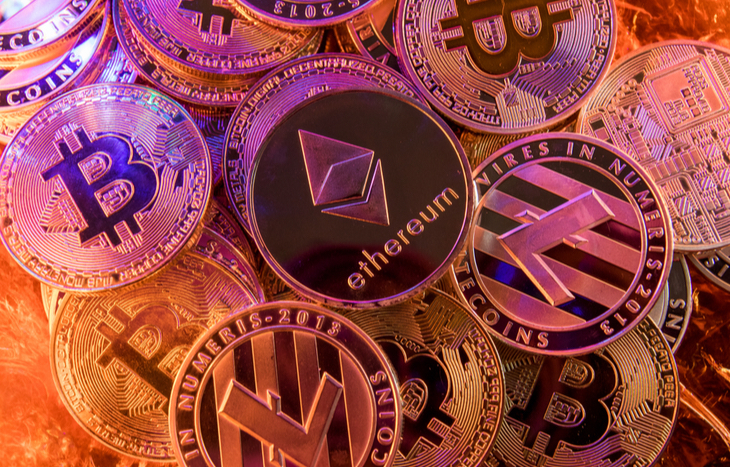How Does the Cryptocurrency Market Work?
Cryptocurrency is more than a trending investment vehicle. Since emerging, the crypto market has become a major market for investors seeking rapid appreciation. Those willing to deal with the volatility of a decentralized currency have found mammoth gains in the likes of Bitcoin and other such crypto assets. For many, however, crypto is still something of a mystery.
If you’re interested in crypto, it’s important to understand the market as a whole—not only the currency. Likewise, if you’re unsure of what crypto is or why it’s valued so heavily, brushing up on your knowledge can help you appreciate peripheral markets, like forex. Here’s a quick overview of the crypto market and its rise to prominence over the past decade.

What is the Cryptocurrency Market?
Cryptocurrency is a form of decentralized currency. It’s a totally digital asset. At its core, cryptocurrency uses blockchain technology to generate hashes (segments of code) unique to each transaction. Think of these as serial numbers. Each time cryptocurrencies exchange hands, hashes get recorded in a decentralized ledger. Ledgers are public, with every transaction recorded in real-time. It’s impossible to fake hashes across every distributed version of the ledger, which means crypto transactions are extremely safe. This is part of the appeal.
Unlike fiat currencies (set by countries), which peg relative value to another currency, crypto derives its value from scarcity and demand. A country can print money and pull financial levers to inflate or deflate its currency value. Because cryptocurrencies aren’t tied to a country, their value is set by investors.
Bitcoin is the most prominent example of a cryptocurrency, but there are hundreds of other coins out there. There’s a growing demand for coins as “tokens,” for specific uses. You could end up paying your phone bill with a crypto token 50 years from now!
Types of Cryptocurrency
Most people use cryptocurrency as a blanket term to talk about crypto assets. The fact is, there are different types of cryptocurrencies—some of which aren’t even utilized as currency, per say. Here’s a look at the three major classes of crypto assets.
Major Currencies
These are cryptocurrencies that function as currency. You can use them to buy goods and trade for other assets. Or, you can hold them as currency and watch their value increase like you would a security.
- Bitcoin
- Ethereum
- Litecoin
Altcoins
Altcoins are different purposes. Some function strictly as currencies. Others represent membership identification in an organization. Others replicate the value of tangible assets, as a placeholder. Generally, the term “altcoin” applies to any cryptocurrency outside of Bitcoin.
- Dogecoin
- Namecoin
- Peercoin
Tokens
Crypto tokens get lumped in with cryptocurrency, but they’re not currency. Instead, they serve a practical function. For example, a utility token might give you access to a specific piece of software. Security tokens confirm user identities. Tokens represent the majority of crypto assets.
- Value tokens
- Security tokens
- Utility tokens
There’s also a new type of crypto asset emerging: digital collectables, powered by blockchain. These aren’t currency—rather, they’re more akin to fine art or other collectables. Their value comes from their originality, which comes from the unique blockchain hash that signifies them as “the original.” They’re quickly becoming the newest must-have crypto investment.
How to Buy, Sell And Trade Cryptocurrency
To understand how and why investors trade cryptocurrency, it’s important to understand where it comes from.
Overall, there are a finite number of tokens for each cryptocurrency, created by solving complex numerical puzzles. As computers process blocks of code to generate answers, they “mine” coins. This process takes a long time and often, costs more in energy processing power than most users reap in crypto value. That said, the value of bitcoin and other cryptocurrencies continues to rise, which prompts continued mining.
If you don’t mine for cryptocurrency, you need to trade for it. To do this, you’ll need a wallet. Digital wallets are easy to come by and you can easily create one through brokerages that allow crypto trading. With a wallet, you’re able to exchange fiat currency for cryptocurrency in the same way you purchase any other security.
As is the case with any secondary market, cryptocurrency has also spawned a derivatives market. If you’re not keen on holding the underlying asset, you can trade crypto futures.
Key Cryptocurrency Terms to Know
The cryptocurrency market is one filled with jargon. It’s in the best interests of prospective investors to get familiar with the major crypto terms they’ll face as they trade these assets (or derivatives). For example, here are a few of the most common terms:
- Blockchain: The underlying technology used to generate and authenticate crypto coins.
- Hash: The identifying “serial number” validating each cryptocurrency transaction.
- Blocks: Huge segments of complex code a computer solves to “mine” cryptocurrency.
- Ledger: The decentralized record of every crypto transaction, composed of hashes.
- Fiat currency: Currencies created and controlled by central banks in different countries.
- ICO: Initial Coin Offering. The process of bringing a cryptocurrency to market.
- Token: A type of crypto asset used for a purpose other than currency.
The further you dive into the evolving world of cryptocurrency, the more terms you’ll find. In addition, get familiar with the basics of both different coins and the underlying blockchain technology. The more you know about how crypto works, the easier it is to speak the language.
The Basic Functions of The Cryptocurrency Market
The primary function of the cryptocurrency market is to buy, sell and exchange cryptocurrencies. But what does this mean? Moreover, what are you investing in? For many crypto investors, it means investing in the future.
To learn more about the crypto boom, sign up for the Profit Trends e-letter below. In fact, you will gain access to daily stock trends, analysis and the best cryptocurrencies to invest in.
Investors believe crypto is the next evolution of many things: security, currency and means of quantification, to name a few. The infallible nature of blockchain means numerous possibilities. When those possibilities come to fruition, it’s crypto backers who will see their early investments soar. Crypto represents what no fiat currency can: boundless, untethered potential.





